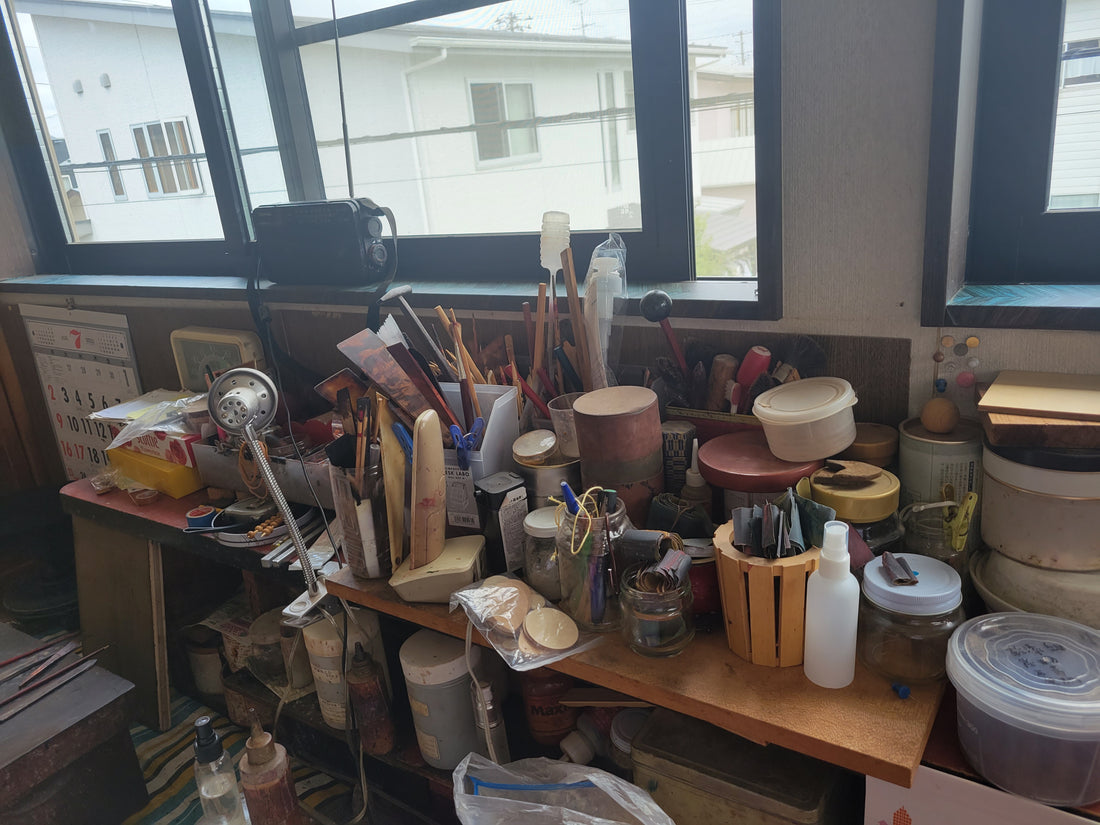Kunio Saito of Urushigei Kobo Saito is working on developing new works that incorporate modern elements while still based on traditional lacquerware.
Mr. Saito, who turns 82 this year, is a veteran of lacquer art with 64 years of experience. He is known as a contemporary master craftsman for his prolific work, which is characterized by the "polishing technique," in which the surface of the pottery is polished after multiple layers of paint are applied, creating a variety of patterns.
In 2008 , he received the National Outstanding Craftsman Award. In the same year, he received the Akita Prefecture Arts and Culture Medal. In 2010 , he received the Yellow Ribbon Medal, and in 2014 , he was named an Akita Prefecture Person of Cultural Merit. He is a leading figure in Akita Prefecture lacquer crafts.
We spoke to Saito about the difficulties and joys of creating lacquerware, the issue of finding successors, and the secret to staying healthy even at over 80 years old.
Acquiring the wide variety of lacquer techniques requires a huge amount of time 
-- Artist Interview --
Please tell us how you first encountered lacquer.
"I was born in Iwaki-cho, Yurihonjo City, and after graduating from junior high school I went to a vocational training school. After studying for a year, I joined the Ikoma Urushi Art Studio in Akita Prefecture, where I have been immersed in the world of lacquer for the past 40 years.
Because the workshop is not an assembly line, it took me about 15 or 16 years before I was able to do all the processes by myself.
There are many different techniques for lacquering, so it takes time to master them. It takes about 20 years to master the top coat, so it takes a fair amount of time."
What are the main techniques used in lacquering?
"Typical lacquers include Ki-urushi, Roiro-urushi, Shugo-urushi, and Kuro-naka-urushi. Roiro-urushi takes time because it is made by applying multiple coats of lacquer and then grinding and polishing it to finish. When I was working at the Ikoma workshop, I studied Shugo-urushi after work and acquired the certification.
For the finishing touch, "hana-nuri," in the case of shugo-urushi lacquer, a glossy lacquer mixed with drying oil is used.
Other techniques include maki-e, which creates patterns by sprinkling gold powder on the surface; raden, which involves carving the mother-of-pearl of shells such as turban shells and abalone into thin sheets, which are then cut into the shape of a pattern and pasted or inlaid on the lacquered surface; eggshell, which involves drawing a pattern in lacquer, then crushing quail eggshells into small pieces and pasting them on top, then coating with lacquer and polishing the surface; and chinkin, which is a technique where patterns are created on the lacquered surface with a chinkin knife by rubbing gold leaf or powder into the engraved areas.
What is the "polishing technique" that you are so good at?
"It is a technique in which a wax-colored lacquer that does not contain oil is applied and then polished with charcoal or horn powder. The more you apply the lacquer, the more glossy it will become. It depends on the piece, but we polish it more than 20 times to create a pattern.
For shibo urushi, tofu is used. The water is removed from the tofu and mixed with the lacquer, and the liquid dries a little, so a pattern is made on the uneven surface with a spatula. After drying within 24 hours, vermilion is applied, and then another 24 hours are left, followed by blue, and so on, applying multiple layers. After drying, the pattern is brought out using a polishing technique with waterproof paper, and then polishing begins, and the process takes about 10 days.
There are about 30 different steps, from applying the base coat to the undercoat, and it takes about a month."
The joy of continuing lacquer crafts blows away the hardships
So it takes a lot of time and a variety of steps to create a single piece.
What are the challenges you face and what brings you joy in continuing to make lacquer?
“There are challenges almost every day. The biggest challenge is humidity. Lacquer is a living thing, so it is affected by humidity, and so mixing the lacquer becomes very difficult during the rainy season.
Also, you have to be careful not to get any dirt on it. It takes a lot of care.
On the other hand, since I make my products at home, I don't have to worry about commuting, and I also sell my products face-to-face while I make them, so I often learn from my customers.
When it's finished I feel like all the hard work has paid off, but I've never been satisfied with it.
But thanks to you, I'm glad I continued."
What do you think about the issue of succession?
"It's difficult to employ people, so I'm passing on my techniques. I've been teaching students from Akita Prefectural University of Art and the Akita Junior College for about 10 years each. I also run experience classes that are open to everyone, from children to adults."
What do you do for a change?
"I take morning walks, and drive or play golf on my days off. I also look forward to having a drink in the evening. Just a 350ml can of beer and a little shochu.
I also value the opportunity to meet with my peers to improve my skills. I think every day is a learning experience.
I go to the studio every day to create something, talk to various people at the sales event, discover new things and get energized, then go back to the studio to create something again. It's the same rotation, but it's encouraging because there's something to do every day."
( TEXT : Natsume Kaoru)
